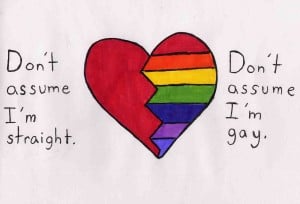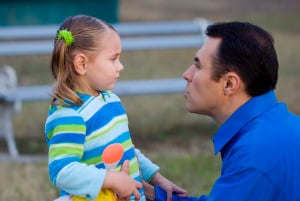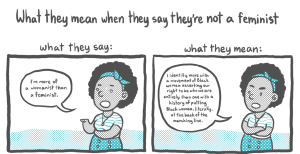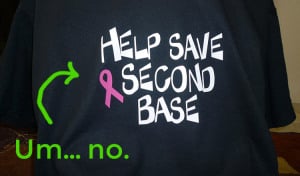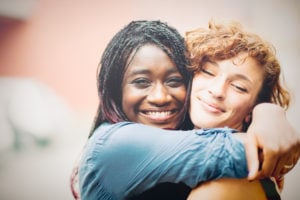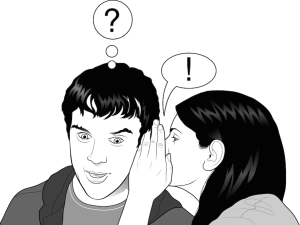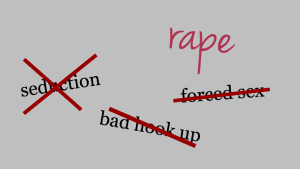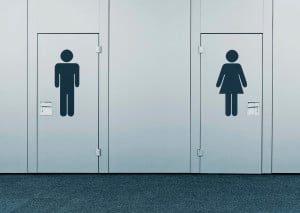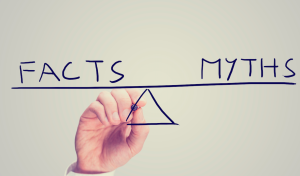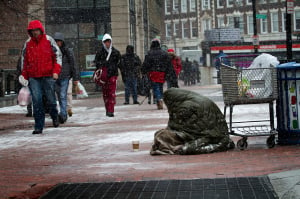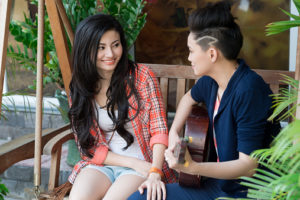
Two people sitting outside while one person has their hand on the other person’s thigh and the other person is holding a guitar
Have you come across the idea that all women are actually bisexual? Ever taken a close look at where that idea comes from?
In 2009, The New York Times Magazine published an article titled “What Do Women Want?” It posited that women were more sexually fluid than men (non-binary people weren’t discussed) and suggested that this was primarily due to nature, not nurture.
The article centered on a study by Queen’s University psychologist Meredith Chivers showing that women’s and trans men’s genitals physically responded to sexual images of both men and women, while men’s and trans women’s tended to respond to one or the other.
Chivers put forth the theory that since vaginal lubrication makes sex more comfortable, people with vaginas benefit from exhibiting it easily, hence their response to a wide range of stimuli. She also suggested that perhaps women are more “receptive” sexually and, therefore, more likely to respond to whoever pursues them.
In 2016, Chivers and her colleagues published a paper in the Journal of Personality and Social Psychology exploring this phenomenon among women of different sexual orientations, finding that lesbians responded more “like men.”
Headlines reporting on it read: “Women Are Either Bisexual or Gay But ‘Never Straight.’ This Is the Fascinating Reason Women Have Evolved to Become Bisexual. Are All Women Actually Bisexual or Gay? All Women Really Bisexual?”
“Even though the majority of women identify as straight, our research clearly demonstrates that when it comes to what turns them on, they’re either bisexual or gay, but never straight,” lead author Dr. Gerulf Rieger told the Telegraph.
If you’re paying attention, you’ll notice that this was a huge leap.
Vaginal lubrication and pupil dilation (the measures in these studies) don’t tell you what people’s desires are because desire is a subjective experience. And, even if they did tell you about people’s desires, what we get turned on by doesn’t have to dictate how we identify.
The claim that women are biologically more likely to get turned on by more than one gender is inherently shaky.
Even University of Utah professor Lisa M. Diamond, who argued that women have less rigid sexual desires than men in Sexual Fluidity: Understanding Women’s Love, has been reconsidering that stance.
After conducting more research finding that many straight men had same-gender attraction, fantasies, and partners, she gave a talk called “I Was Wrong! Men’s Sexuality is Pretty Darn Fluid Too.”
Nevertheless, the idea that all women are bisexual, all men are gay or straight, and non-binary people don’t exist has already been engrained in our culture’s collective consciousness and comes up often in everyday conversations.
I’ve found this extremely invalidating both as a woman who has exclusively been attracted to men and as someone who has dated polysexual men.
It’s true that more women than men in the US identify as bisexual (more than five percent of women compared to two percent identify this way, according to a CDC survey taken between 2011 and 2013).
But it’s super problematic to say this is biological or that it means all, or even most women, are bisexual.
Here’s why.
1. It’s Not Okay to Define Anyone Else’s Sexual Orientation
Again, there’s a huge leap between observing that someone’s pupils dilate when they see naked men and women and calling them bisexual.
Many factors go into our sexual identity, including who we date, who we want to date, who turns us on, and who we’ve had sex with, and it’s entirely up to us which things we do or don’t factor in.
Some people, for example, may fantasize about someone of one gender but never want to act on it, so they don’t identify with those fantasies. Others may consider the fantasy alone reason enough to identify as queer.
And while some proudly assume a queer identity, many literally don’t feel safe identifying this way, and that’s okay.
“Bisexual” means many different things to different people, and no scientist gets to hijack its definition.
Nobody has the right to tell anyone what their sexual orientation is, no matter how many measurements they’ve taken.
And trying to make that call for someone takes away one of the most important powers we have: the power to define ourselves.
2. Calling Straight People Bisexual Invalidates Actual Bisexual People
There’s a huge difference between openly identifying as bisexual and identifying as straight while occasionally having same-gender attraction (or not even having attraction but exhibiting physical signs of arousal in response to same-gender images).
Bisexual people face a ton of discrimination, and straight people trivialize that when they say “everyone’s a little bit bi” or “all women are bisexual.”
Not all women have been excluded by both straight and gay people, been told that their identity is just for attention, or been treated like their relationships are less real.
Bisexuality is a real identity, not just a word to throw around to discuss study results.
3. Using Only the Word Bisexual Erases Other Non-Monosexual Orientations
When researchers use the word bisexual to mean “attracted to more than one gender,” they usually fail to acknowledge that there are more than two genders out there – and that there’s more than one way to name your attraction to multiple genders.
People who are interested in people of more than one gender may identify as pansexual, for example, if they label their sexuality at all.
Additionally, we can’t ignore that plenty of folks are asexual, regardless of whether or not they experience attraction to people of any gender.
Many bisexuals use an inclusive definition of bisexual to include non-binary people, instead of the dictionary’s definition of “bisexual” as “sexually attracted to both men and women.”
But those who posit that all women are bisexual rarely consider other a/genders – hence their neglect of other non-monosexual orientations.
Using bisexual for studies that are limited to cis men and women erases the work of bisexual activists advocating for visibility for trans and non-binary people in their community.
And using it as shorthand for every polysexual identity erases the important reasons why some people identify with other terms.
4. It Furthers Negative Ideas About Women
The explanations given for why more women than men are bisexual often sound suspiciously like gender stereotypes.
For example, the idea Chivers brought up that women are sexually more “receptive” and less “go-out-there-and-get-it” coincides with a broader view of women as passive.
Another idea I’ve heard many people cite for women’s supposedly more frequent bisexuality is that women are beautiful.
I recently interviewed three experts about why straight women sometimes fantasize about other women, and two of them said it’s because women’s bodies are aesthetically pleasing. As if that’s some objective fact.
Sexualized images of women are all around us, encouraging our view of women as “the fair sex.” But since this cultural view stems from the objectification of women, dismissing it as natural contributes to such objectification.
The notion that women can’t help but be sexually attracted to women since women are “so sexy” also stems from and encourages the exoticization of women.
“Us girls, we are so magical, soft skin, red lips, so kissable, hard to resist, so touchable,” Katy Perry sings in “I Kissed a Girl.” This line depicts a very stereotypical, objectified version of womanhood that treats women more like fairies or unicorns than actual people.
Women are mysterious, we’re taught. Women are exotic. Women are so nice to look at.
The idea lurking behind these claims is that women are by nature objects, and, therefore, they must be the object of everyone’s affections.
While there’s nothing wrong with personally being attracted to women, acting like attraction to women reflects some sort of objective truth encourages a lot of misogynistic ideas.
5. It Stigmatizes Male Sexual Fluidity Even More
One very likely explanation for the greater number of women identifying as bisexual in the US is that it’s more socially acceptable for women than it is for men. And by claiming that women are naturally more bisexual, we’re only contributing to that social norm.
Statements about women’s innate bisexuality usually contrast it with men’s straight-or-gay sexuality and erase non-binary people, who can’t say they’re attracted to the “same” or “opposite” gender.
In reality, many people who aren’t women date, are attracted to, have sex with, or physically respond to more than one gender.
Similarly to women, men’s eyes will dilate in response to videos of both men and women masturbating, according to research by Cornell University professor Ritch C. Savin-Williams.
That goes to show that every group’s sexuality is less black and white than we thought. It doesn’t measure bisexuality, but an increasing number of men do identify as bisexual, and more probably would if people stopped saying it was inherently a female thing.
***
When that New York Times Magazine article came out, a lot of my friends thought it was great for feminism. Finally, they said, we’re thinking about what women desire, rather than just assuming everyone’s like men.
But we need to think about what we mean when we say “like men.”
Maybe men aren’t all really “like men” either, if “like men” means having a narrow sexual orientation in which you’re only attracted to, turned on by, and romantically interested in one gender.
Some men may be like this, but some women and non-binary people are, too. And many aren’t.
Women’s supposed sexual fluidity is sometimes celebrated as an alternative to a rigid, patriarchal, gender-role-based model of sexuality. But we can celebrate this alternative without attributing it to women in general or to women exclusively.
This form of celebration is part of a larger movement of feminists celebrating women based on their supposed differences from men. In a culture where traditionally masculine traits are disproportionately celebrated, it makes sense that we would want this.
But we’re not really celebrating women if we’re imposing an identity upon them that’s heavily based on stereotypes.
And by asserting that men’s sexuality does fit the societal norm, we’re putting them in a box, too.
We’re also ignoring all the people that don’t adhere to the gender binary and resist the narrow gender norms we can uphold when we try to fit everyone into the boxes of “straight,” “gay,” and “bisexual.”
So, we can talk about how people are more sexually fluid than previously thought, and we can talk about how women in our society are more likely to openly identify as bisexual. We can even talk about studies showing gender differences in sexual responses to images.
But let’s not use any of this information to decide what someone else’s – or an entire group’s – sexual orientation is. Only they themselves can tell us that.
[do_widget id=’text-101′]
Suzannah Weiss is a Contributing Writer for Everyday Feminism. She is a New York-based writer whose work has appeared in The Washington Post, Salon, Seventeen, BuzzFeed, The Huffington Post, Bustle, and more. She holds degrees in Gender and Sexuality Studies, Modern Culture and Media, and Cognitive Neuroscience from Brown University. You can follow her on Twitter @suzannahweiss. Read her articles here.
Search our 3000+ articles!
Read our articles about:
Our online racial justice training
Used by hundreds of universities, non-profits, and businesses.
Click to learn more





